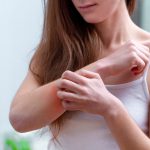Ashwagandha in Sanskrit means “smell of the horse” to correlate it with the strength of…
Read MoreDid you know that between the ages of 11 and 30 around 95% of people get acne?[1][Overview Acne](https://www.nhs.uk/conditions/acne/ “Overview Acne”). NHS UK. This condition is caused when pores in your skin get blocked by dead cells and oil. Pimples develop most commonly on the face but these lesions may also break out on your chest, back, or shoulders.
Based on the severity of your condition you might get
According to Ayurveda, acne or yauvana pidika is a minor condition or kshudra roga. It is believed to occur due to an imbalance in rakta (blood which is related mainly to the fire element, pitta), kapha (related to the elements of water and earth), and vata (related to the elements of air and ether) in the body.[2]Pampaniya, Piyush V., and Darshana H. Pandya. “Effect of Shalmalyadilepa and Guduchyadivati in the management of Yauvanapidika (Acne).” Ayu 34, no. 2 (2013): 174.
Our skin contains small pores called hair follicles out of which hair grows. They are attached to glands known as sebaceous glands which produce sebum or oil to lubricate hair and skin. But if excess sebum is produced then it can blend with dead skin cells and plug hair follicles. This causes whiteheads or blackheads to form. Clogged pores can also get infected by bacteria which commonly live on your skin resulting in inflammation and the development of nodules, pustules, cysts, or papules. Excess production of sebum, clogged hair follicles, inflammation, and bacteria are the main factors that lead to acne. But other factors can increase your likelihood of suffering from this condition too:
Family history has been found to have an impact on whether you get acne. According to experts, genetics has a part to play in the development of acne. If your parents suffered from it, your chances of getting acne increase. This holds true for adult acne too, you’re at higher risk for it if either or both of your parents had it.
Hormones have a bearing on acne. Teenage acne is thought to be set off by higher levels of testosterone experienced during puberty. This hormone can stimulate your glands to produce more sebum. Changes in hormone levels experienced during periods or pregnancy can also lead to outbreaks. Polycystic ovary syndrome, which is a hormonal disorder, has also been found to trigger acne.
Some medicines like lithium or steroids have been found to trigger acne. Certain medicines used in the treatment of epilepsy can do this too. Check with your doctor to figure out if any medicine that you’re on can cause acne outbreaks.
Factors like stress, humidity, pollution, pressure on your skin from tight clothes, backpacks, helmets etc. can exacerbate acne too. Picking at pimples or scrubbing your skin roughly can also worsen this condition.[3][Causes Acne](https://www.nhs.uk/conditions/acne/causes/ “Causes Acne”). NHS UK. [4][What causes acne?]( https://www.niams.nih.gov/health-topics/acne#tab-causes “What causes acne?”). National Institutes of Health.
Some research indicates that your diet can also have an impact on acne. Specifically, a low-glycemic diet has been found to be helpful in tackling this condition. The glycemic index assigns a number that measures how foods impact your blood sugar. A low glycemic diet will contain foods that won’t increase your blood sugar levels by large amounts. Typically, this would include foods like raw carrots, chickpeas, kidney beans, green vegetables, and fruits since they have low glycemic index values.[5][ Glycemic index diet: What’s behind the claims](https://www.mayoclinic.org/healthy-lifestyle/nutrition-and-healthy-eating/in-depth/glycemic-index-diet/art-20048478 “Glycemic index diet: … Continue reading Increasing your intake of omega-3 and omega-6 fatty acids by consuming healthy oils and fish is also beneficial for acne. Meanwhile, whey proteins present in milk could contribute to the development of acne.[6]Baldwin, Hilary, and Jerry Tan. “Effects of diet on acne and its response to treatment.” American Journal of Clinical Dermatology 22, no. 1 (2021): 55-65. So eating a healthy diet can help you avoid those zits.
While your doctor can prescribe medications to treat severe acne here are some herbal remedies to treat acne naturally.
Manjistha is prized in Ayurveda for its ability to treat skin diseases. Research indicates that it can be effective against acne. Studies have found that it’s antibacterial and acts against the bacteria Propionibacterium acnes which plays a role in the formation of pimples.[7]Gorle, Archana M., and Swati S. Patil. “Evaluation of antioxidant and antiacne property of Rubia cordifolia.” Der Pharmacia Sinica 1, no. 3 (2010): 59-63. It also has anti-inflammatory properties which makes it beneficial in easing inflammation associated with acne.[8]Jain, A., and E. Basal. “Inhibition of Propionibacterium acnes-induced mediators of inflammation by Indian herbs.” Phytomedicine 10, no. 1 (2003): 34-38. Moreover, this powerful herb may help fade dark spots and hyperpigmentation caused by acne. That’s because acne spots are caused by the overproduction or irregular dispersion of a pigment known as melanin. And manjistha can inhibit the enzyme tyrosinase which plays a role in the production of this pigment.[9]Sharma, Khemchand, Namrata Joshi, and Chinky Goyal. “Critical review of Ayurvedic Varṇya herbs and their tyrosinase inhibition effect.” Ancient Science of life 35, no. 1 (2015): 18.
Neem has traditionally been highly valued for its many medicinal properties. It has also been found to be effective in tackling acne. One study found that neem extract was useful in inhibiting Propionibacterium acne, which has a part to play in the development of pimples.[13]Daud, Farhat S., Gauri Pande, Mamta Joshi, Ruchita Pathak, and Shubhangi Wankhede. “A study of antibacterial effect of some selected essential oils and medicinal herbs against acne causing … Continue reading
Here’s an ancient remedy for acne all the way from Australia – tea tree oil – which is extracted from the leaves of the tea tree. Aboriginal Australians have long used it for getting rid of skin infections. Research indicates that it’s effective against bacteria which promote acne. Beneficial compounds like α-pinene, terpinen-4-ol, and α-terpine are responsible for the antibacterial properties of this essential oil.[15]Raman, A., U. Weir, and S. F. Bloomfield. “Antimicrobial effects of tea‐tree oil and its major components on Staphylococcus aureus, Staph. epidermidis and Propionibacterium acnes.” … Continue reading
Witch hazel contains tannins and is another herbal remedy that is used for treating pimples. These compounds are considered to be responsible for its astringent quality which is helpful in fighting acne.
Calendula or pot marigold can also help you beat acne. It is antibacterial and can inhibit Propionibacterium acnes.[18]Vora, Jaykant, Anshu Srivastava, and Hashmukh Modi. “Antibacterial and antioxidant strategies for acne treatment through plant extracts.” Informatics in Medicine unlocked 13 (2018): … Continue reading It’s anti-inflammatory properties make it particularly helpful in dealing with those infuriating zits. It is thought to exert an anti-inflammatory effect by inhibiting enzymes (Cox-2) and proteins (proinflammatory cytokines) which play a role in inducing inflammation.[19]Preethi, Korengath Chandran, Girija Kuttan, and Ramadasan Kuttan. “Anti-inflammatory activity of flower extract of Calendula officinalis Linn. and its possible mechanism of action.” … Continue reading
We’ve all heard of the amazing health benefits of green tea. But did you know that it can tone down oily skin and help fight acne? According to a study pimples were reduced by 58.33% when a lotion containing green tea was applied twice a day for six weeks.[22]Elsaie, Mohamed L., Mahmoud F. Abdelhamid, Lotfy T. Elsaaiee, and Hanaa M. Emam. “The efficacy of topical 2% green tea lotion in mild-to-moderate acne vulgaris.” Journal of drugs in … Continue reading Another study also found that the application of green tea for 15 days led to a 27% reduction in sebum.[23]Mahmood, T., N. Akhtar, and C. Moldovan. “A comparison of the effects of topical green tea and lotus on facial sebum control in healthy humans.” Hippokratia 17, no. 1 (2013): 64. Green tea does this by inhibiting 5α-reductase, an enzyme which acts on your hormones to increase sebum production.[24][Sebum](Sebum | DermNet NZ “Sebum”). Dermnet NZ.
Green tea also has potent antimicrobial and antioxidant effects which also contribute to its anti-acne properties.
Chamomile is another herb that attacks acne causing bacteria.[25]Zu, Yuangang, Huimin Yu, Lu Liang, Yujie Fu, Thomas Efferth, Xia Liu, and Nan Wu. “Activities of ten essential oils towards Propionibacterium acnes and PC-3, A-549 and MCF-7 cancer … Continue reading It also has anti-inflammatory properties and has traditionally been used to ease skin inflammation.
References
| ↑1 | [Overview Acne](https://www.nhs.uk/conditions/acne/ “Overview Acne”). NHS UK. |
|---|---|
| ↑2 | Pampaniya, Piyush V., and Darshana H. Pandya. “Effect of Shalmalyadilepa and Guduchyadivati in the management of Yauvanapidika (Acne).” Ayu 34, no. 2 (2013): 174. |
| ↑3 | [Causes Acne](https://www.nhs.uk/conditions/acne/causes/ “Causes Acne”). NHS UK. |
| ↑4 | [What causes acne?]( https://www.niams.nih.gov/health-topics/acne#tab-causes “What causes acne?”). National Institutes of Health. |
| ↑5 | [ Glycemic index diet: What’s behind the claims](https://www.mayoclinic.org/healthy-lifestyle/nutrition-and-healthy-eating/in-depth/glycemic-index-diet/art-20048478 “Glycemic index diet: What’s behind the claims”). Mayo Clinic. |
| ↑6 | Baldwin, Hilary, and Jerry Tan. “Effects of diet on acne and its response to treatment.” American Journal of Clinical Dermatology 22, no. 1 (2021): 55-65. |
| ↑7 | Gorle, Archana M., and Swati S. Patil. “Evaluation of antioxidant and antiacne property of Rubia cordifolia.” Der Pharmacia Sinica 1, no. 3 (2010): 59-63. |
| ↑8 | Jain, A., and E. Basal. “Inhibition of Propionibacterium acnes-induced mediators of inflammation by Indian herbs.” Phytomedicine 10, no. 1 (2003): 34-38. |
| ↑9 | Sharma, Khemchand, Namrata Joshi, and Chinky Goyal. “Critical review of Ayurvedic Varṇya herbs and their tyrosinase inhibition effect.” Ancient Science of life 35, no. 1 (2015): 18. |
| ↑10 | Sharma, Laxmikant, Gaurav Agarwal, and Ashwani Kumar. “Medicinal plants for skin and hair care.” (2003). |
| ↑11, ↑20 | Julianti, Elin, Kasturi K. Rajah, and Irda Fidrianny. “Antibacterial activity of ethanolic extract of cinnamon bark, honey, and their combination effects against acne-causing bacteria.” Scientia pharmaceutica 85, no. 2 (2017): 19. |
| ↑12 | [Allergy testing](https://www.betterhealth.vic.gov.au/health/conditionsandtreatments/allergy-testing “Allergy testing”). Better Health Channel. |
| ↑13 | Daud, Farhat S., Gauri Pande, Mamta Joshi, Ruchita Pathak, and Shubhangi Wankhede. “A study of antibacterial effect of some selected essential oils and medicinal herbs against acne causing bacteria.” International journal of pharmaceutical science Invention 2, no. 1 (2013): 27-34. |
| ↑14 | Gamwell, Calvert. 95 Surprisingly Effective Natural Ways to Fight Acne. Human Innovation Labs, 2011. |
| ↑15 | Raman, A., U. Weir, and S. F. Bloomfield. “Antimicrobial effects of tea‐tree oil and its major components on Staphylococcus aureus, Staph. epidermidis and Propionibacterium acnes.” Letters in applied microbiology 21, no. 4 (1995): 242-245. |
| ↑16 | Eden Noronha. [3 Ways To Use Tea Tree Oil On Your Skin]( 3 Ways To Use Tea Tree Oil On Your Skin (femina.in)“3 Ways To Use Tea Tree Oil On Your Skin”). Femina.2020. |
| ↑17 | Shenefelt, Philip D. “Herbal treatment for dermatologic disorders.” (2012). |
| ↑18 | Vora, Jaykant, Anshu Srivastava, and Hashmukh Modi. “Antibacterial and antioxidant strategies for acne treatment through plant extracts.” Informatics in Medicine unlocked 13 (2018): 128-132. |
| ↑19 | Preethi, Korengath Chandran, Girija Kuttan, and Ramadasan Kuttan. “Anti-inflammatory activity of flower extract of Calendula officinalis Linn. and its possible mechanism of action.” (2009). |
| ↑21 | Kristin Collins Jackson.[Calendula Recipes That Are Super Easy to Make] (Using Calendula Oil For Acne & Scalp Health Will Make Your Skin Celebrate (http://www.bustle.com)“Calendula Recipes That Are Super Easy to Make”).Bustle.2016 |
| ↑22 | Elsaie, Mohamed L., Mahmoud F. Abdelhamid, Lotfy T. Elsaaiee, and Hanaa M. Emam. “The efficacy of topical 2% green tea lotion in mild-to-moderate acne vulgaris.” Journal of drugs in dermatology: JDD 8, no. 4 (2009): 358-364. |
| ↑23 | Mahmood, T., N. Akhtar, and C. Moldovan. “A comparison of the effects of topical green tea and lotus on facial sebum control in healthy humans.” Hippokratia 17, no. 1 (2013): 64. |
| ↑24 | [Sebum](Sebum | DermNet NZ “Sebum”). Dermnet NZ. |
| ↑25 | Zu, Yuangang, Huimin Yu, Lu Liang, Yujie Fu, Thomas Efferth, Xia Liu, and Nan Wu. “Activities of ten essential oils towards Propionibacterium acnes and PC-3, A-549 and MCF-7 cancer cells.” Molecules 15, no. 5 (2010): 3200-3210. |
| ↑26 | Elda Watulo. How to Get Rid of Acne. Hot Methods.2012 |


Dr. Aswathy has 10+ years of experience as an Ayurvedic consultant and medical officer in different nursing homes and hospitals. She has a deep knowledge of classical texts, Ayurvedic treatments, and Panchkarma. Dr. Aswathy is proficient in diagnosis through traditional Ayurvedic means and plans treatment that is specific to an individual’s constitution.

Ashwagandha in Sanskrit means “smell of the horse” to correlate it with the strength of…
Read More
Pimples - we’ve all had them and we all hate them. And if you’ve ever…
Read More
Don’t all of us want healthy glowing skin? And while there is a ton of…
Read More
Most of us have experienced skin irritations at some point or the other. When the…
Read More